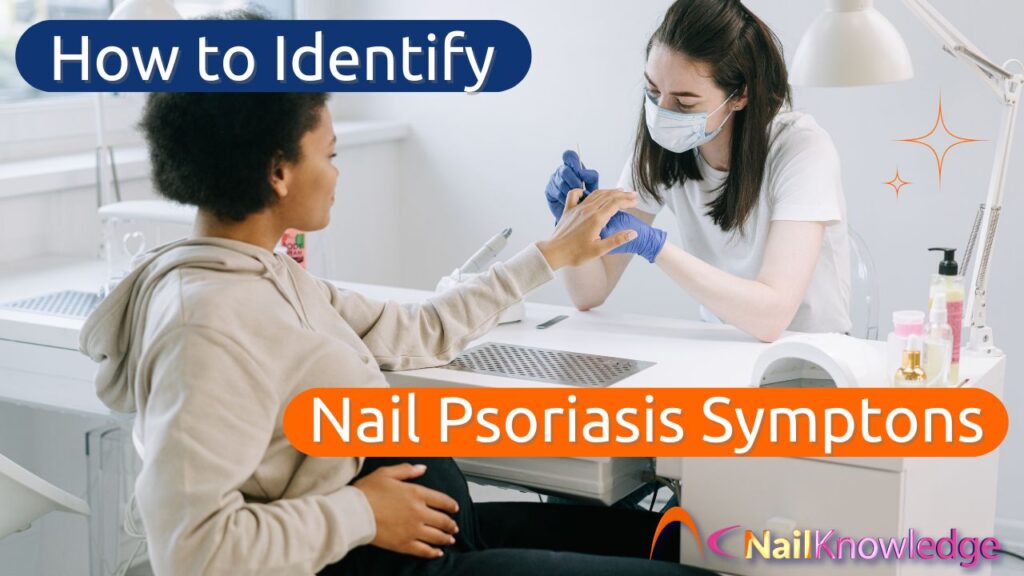Como identificar os sintomas de psoríase nas unhas em clientes com confiança e cuidado
As nail professionals, we often spend more time examining our clients’ nails than they do themselves. Whether you’re prepping for a manicure, applying gel, or giving a hand massage, you’re in a unique position to notice early warning signs of certain conditions, like nail psoriasis. It’s not uncommon for clients to be completely unaware of what’s happening under the polish. Spotting potential nail psoriasis symptoms in clients isn’t about diagnosing but about being observant and informed so you can offer the best advice and ensure their wellbeing.
So how do you recognise the signs of nail psoriasis without alarming your client, and when should you recommend they speak to a healthcare provider? Let’s explore the clues, what they mean, and how to navigate the conversation professionally.
Reconhecendo os sinais visuais da psoríase das unhas no salão de beleza
Nail psoriasis can be tricky to spot because it shares symptoms with other nail conditions. Most commonly, it appears in individuals who already have psoriasis on their skin, but it’s not limited to them. Interestingly, only about 5 percent of people with psoriasis experience symptoms limited to the nail plate. However, those with psoriatic arthritis, especially in fingers and toes, often show signs in their nails as well.
This condition isn’t contagious. It doesn’t come from bacteria, fungi, or any outside source. Instead, it’s rooted in the immune system and often runs in families. That means it’s not a hygiene issue, which is an important distinction to make when explaining it to a client.
You’re not expected to identify medical issues. But spotting changes in the nails helps you offer guidance and shows your professionalism.
Mudanças na cor e na textura da superfície a serem observadas
When scanning your client’s nails during a service, there are a few tell-tale signs that may point to nail psoriasis symptoms in clients. One of the most recognisable is the “salmon patch.” These look like tiny drops of oil or blood trapped under the nail plate and tend to appear pinkish or reddish in tone.
Other discolouration might include patches of green, yellow, or brown. These could be mistaken for fungal infections or bruising, but if seen in combination with other symptoms, they may be signs of psoriasis.
Surface texture is another clue. The nail plate might develop small pits or indentations, like pinpricks scattered across the surface. These pits can be random or neatly aligned, giving the nails an unusual, rough appearance even though they haven’t been filed.
In more advanced cases, the nail may become thicker, appear chalky underneath, or start crumbling at the free edge. This brittleness is a result of weakened nail structure, not neglect.
Separação das unhas, sangramento e sensibilidade
If you notice the nail lifting from the nail bed, beginning at the free edge and pulling back toward the cuticle, this condition is known as onycholysis. It’s a common issue for those with nail psoriasis and can open the door to secondary infections.
Você também pode ver hemorragias por estilhaçosAs manchas são pequenas linhas pretas que correm na direção do crescimento da unha. Elas são causadas por capilares rompidos no leito ungueal e geralmente são inofensivas, mas sua presença, juntamente com outros sinais, reforça a necessidade de encaminhar o cliente a um profissional médico.
Vermelhidão em a lúnula (the half-moon at the base of the nail) and inflammation around the nail folds (known as paronychia) can also be part of the picture. These symptoms may make the nails feel sore or tender, which the client might casually mention in conversation without realising it’s a sign of something more.
Comunicar suas preocupações sem alarmes
When you’re faced with several of these symptoms at once, it’s wise to gently suggest your client consult a dermatologist or podiatrist. The key here is tone. Avoid sounding alarmed or overly clinical. Instead, speak in calm, neutral language that keeps the focus on their health.
For example, you could say: “I’ve noticed a few changes in your nails that I think are worth showing to a dermatologist. It’s nothing to panic about, but it could be something like nail psoriasis, and they’ll be able to give you a clear answer.”
This approach respects the client, keeps their dignity intact, and shows that you’re looking out for their overall wellbeing, not just their manicure.
Práticas seguras para psoríase das unhas no ambiente do salão de beleza
Despite its appearance, nail psoriasis is not caused by an infection, and it cannot be passed from one person to another. That means it’s completely safe to carry out nail services, as long as the client is comfortable and the nail bed is not open or actively inflamed.
In fact, well-applied artificial nail coatings can help protect the nail from further trauma. UV gel manicures, acrylic overlays, and other professional coatings are not harmful to the condition. Just be sure the nail isn’t lifting or damaged to the point of exposing the nail bed, as that could invite irritation or infection.
Conselhos sobre cuidados diários com as unhas para clientes com sintomas de psoríase nas unhas
Although there is no cure, many clients benefit from practical, everyday care tips to manage nail psoriasis. Encourage them to keep nails short and the free edge smoothly filed. Suggest wearing gloves while doing housework or gardening, especially during colder months. A high-quality skin conditioner can help prevent cracking and dryness, which often aggravate symptoms.
Sapatos confortáveis e bem ajustados também são importantes, principalmente para aqueles que se exercitam regularmente. Para clientes abertos a tratamento médico, informe-os de que há terapias disponíveis, desde cremes tópicos até injeções e tratamentos leves. Isso pode oferecer um alívio significativo, mesmo que os resultados demorem a aparecer.
Quando encaminhar seu cliente
Consulte um podólogo se seu cliente tiver:
- Dor, inchaço, sangramento ou sensibilidade ao redor da unha
- Unhas com mau cheiro ou que parecem infectadas
- Symptoms that aren’t improving after self-treatment
- Alterações em várias unhas, especialmente se elas parecerem simétricas
- Histórico pessoal ou familiar de psoríase ou problemas de pele
- Any unusual or concerning changes you’re unsure about
Acha que seu cliente tem uma infecção fúngica nas unhas? Na verdade, pode ser psoríase ungueal. Saiba como identificar a diferença, evitar diagnósticos incorretos e proteger a higiene do salão.
Considerações finais sobre a identificação de sintomas de psoríase nas unhas em clientes
As a beauty professional, you’re not there to diagnose condições médicas, but your role can still be powerful. By being informed about nail psoriasis symptoms in clients, you’re better equipped to support them with empathy, professionalism and the right advice.
Clients trust you not just for beautiful nails, but for your expertise. When you notice changes in nail texture, colour, or structure, you have the opportunity to guide them toward the care they might need, without judgment or alarm. That’s a mark of true professionalism.
Fungal Infection or Nail Psoriasis? Here’s How to Tell the Difference
Você acha que seu cliente tem uma infecção fúngica nas unhas? Na verdade, pode ser psoríase ungueal. Saiba como identificar a diferença, evitar diagnósticos incorretos e proteger a higiene do salão.


